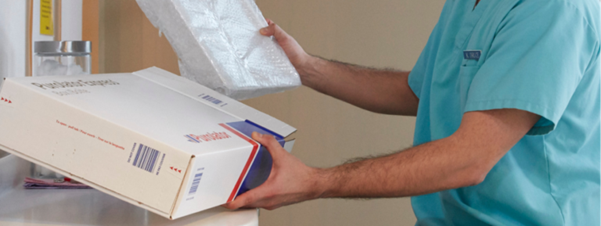
Jason Hern
General Manager Healthcare, Purolator Inc.
There are about 7,000 km between the east and west coasts of Canada – a journey of a few weeks for most of us, and a stark example of the vast landscape when it comes to shipping within Canada. While most people live near urban centres, many do not – yet all of them will at some point have specific, often urgent health care needs.
There is no question that health-care shippers are a crucial part of the health-care system. We have an important responsibility to ensure access to care by delivering what patients need, no matter where they are in the country.
This includes deliveries from medical device manufacturers, medical and dental suppliers, pharmaceutical companies and diagnostic companies – often time-sensitive shipments, with complex delivery requirements or specialized handling needs. Community-level hospitals and clinics often have limited inventory and rely on these shipments to be able to provide optimal patient care.
This responsibility came into sharp focus during the pandemic, when the transportation industry was declared an essential service. During that time, Purolator delivered millions of crucial supplies of PPE, COVID tests and, eventually, vaccines across the country. Yet while the pandemic illuminated the need for reliable, expedited access to care, it did not diminish the ongoing need for it into the future. In fact, it’s predicted that the global medical courier market will reach US$4.9 billion by 2030, fuelled by incredible innovations in medicine that are increasingly becoming available.
An equally important consideration is the emotional nature inherent in these types of deliveries – and it’s what makes this sector unique. Because at the end of every last mile there’s a patient waiting for that medicine, or equipment or tools that will enable them to live their best life.
In this way, couriers have a deep responsibility, one that requires experience and systems that ensure on-time fulfilment, even in the face of complex situations, every single time.
The need for reach – and speed
When it comes to critical healthcare products, two of the most important aspects of shipping are reach and speed. This carries added weight when you consider the official promise that underlines the Canadian healthcare system: that no matter where you live or what you earn, you are able to receive the medical care you need.
Equitable access to care is a major focus and, due to Canada’s geography, a preeminent logistical challenge. For manufacturers of medical devices, vaccines and medications, having a transportation provider that can capably access these diverse locations is an imperative.
At Purolator, we are so proud to say that we deliver to all of Canada’s approximately 1,400 hospitals – and can reach more than 90 per cent of them with next day transit from a single centralized distribution centre. A recent industry analysis in fact found that our express service offers the fastest domestic shipment times, as compared to FedEx and UPS, including rural destinations.
With these sensitive packages in mind, senders and receivers need visibility and reliability. The fewer times packages change hands, or carriers, the better – but oftentimes, secondary couriers are used to reach less populated areas. Purolator will do so only when faced with a crisis-level situation – for example, an antidote must reach a poison victim. In such a scenario, our Mission Critical service is deployed, meaning we will get packages quickly to the nearest possible location and use a regional partner for next-flight-out service to that clinic.
That sort of flexibility takes on considerable magnitude when people’s health is on the line.
Innovation is key in shipping health care
Leaving aside temperature control – a key topic for which I’ll dedicate an article to in this series – couriers in the business of shipping for the health-care industry must consider how innovation plays a role in expedient, visible delivery. Ultimately, these highly valuable products must travel exactly as promised, and arrive on time. That requires them to leave true, real-time footprints.
At Purolator, we’ve developed our H+ product, a system that ensures Healthcare shipments are given maximum priority. While a sticker on each package serves as a visual identifier, we also ensure that barcodes are embedded with special identifiers – which then connect a digital flag throughout the network.
Inside any facility, our technology will prioritize these critical packages, ensuring the most expedient movement through our network. In the event of a disruption, teams can clearly see which facilities or trailers contain healthcare packages, and subsequently prioritize them. While in transit, the digital identifier means healthcare packages are visible to our drivers on their handheld devices, allowing proper last mile prioritization to clinics, hospitals, and direct to patients.
Because of Purolator’s nationwide reach, these end-to-end digital solutions can be quickly and completely rolled out in all facilities, vehicles, and drivers. This ensures the entire network has access to the tools needed to make healthcare prioritization as seamlessly as possible.
In the next article in this series, I’ll explore the vital considerations when health-care supplies originate outside of Canada – and the same speed and reliability takes on an international scope.
Written by Jason Hern, General Manager Healthcare, Purolator

